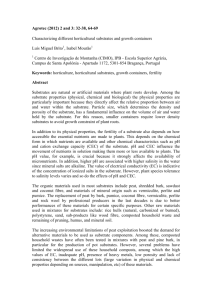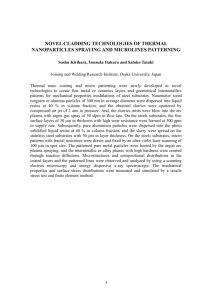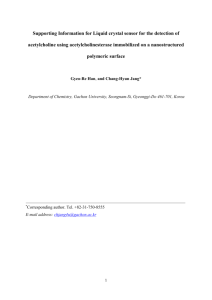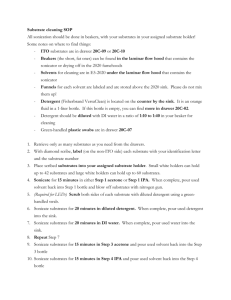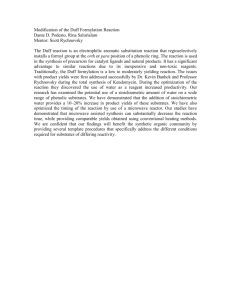A Review Of Substrates Used In Tarantula Vivaria Richard C. Gallon
advertisement
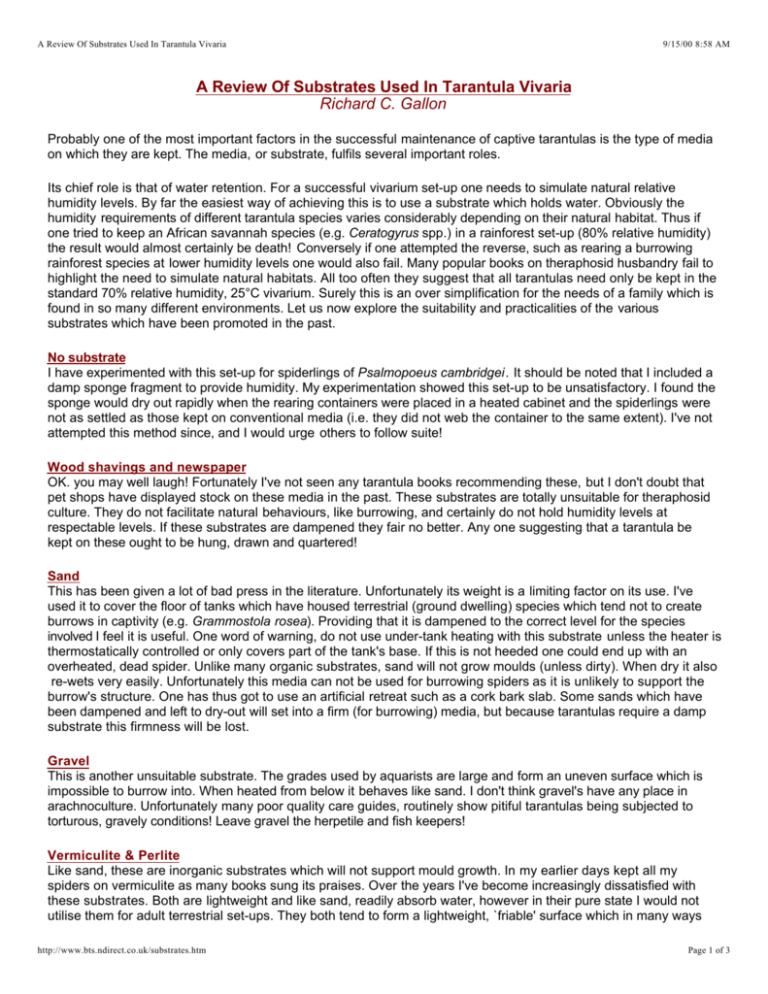
A Review Of Substrates Used In Tarantula Vivaria 9/15/00 8:58 AM A Review Of Substrates Used In Tarantula Vivaria Richard C. Gallon Probably one of the most important factors in the successful maintenance of captive tarantulas is the type of media on which they are kept. The media, or substrate, fulfils several important roles. Its chief role is that of water retention. For a successful vivarium set-up one needs to simulate natural relative humidity levels. By far the easiest way of achieving this is to use a substrate which holds water. Obviously the humidity requirements of different tarantula species varies considerably depending on their natural habitat. Thus if one tried to keep an African savannah species (e.g. Ceratogyrus spp.) in a rainforest set-up (80% relative humidity) the result would almost certainly be death! Conversely if one attempted the reverse, such as rearing a burrowing rainforest species at lower humidity levels one would also fail. Many popular books on theraphosid husbandry fail to highlight the need to simulate natural habitats. All too often they suggest that all tarantulas need only be kept in the standard 70% relative humidity, 25°C vivarium. Surely this is an over simplification for the needs of a family which is found in so many different environments. Let us now explore the suitability and practicalities of the various substrates which have been promoted in the past. No substrate I have experimented with this set-up for spiderlings of Psalmopoeus cambridgei . It should be noted that I included a damp sponge fragment to provide humidity. My experimentation showed this set-up to be unsatisfactory. I found the sponge would dry out rapidly when the rearing containers were placed in a heated cabinet and the spiderlings were not as settled as those kept on conventional media (i.e. they did not web the container to the same extent). I've not attempted this method since, and I would urge others to follow suite! Wood shavings and newspaper OK. you may well laugh! Fortunately I've not seen any tarantula books recommending these, but I don't doubt that pet shops have displayed stock on these media in the past. These substrates are totally unsuitable for theraphosid culture. They do not facilitate natural behaviours, like burrowing, and certainly do not hold humidity levels at respectable levels. If these substrates are dampened they fair no better. Any one suggesting that a tarantula be kept on these ought to be hung, drawn and quartered! Sand This has been given a lot of bad press in the literature. Unfortunately its weight is a limiting factor on its use. I've used it to cover the floor of tanks which have housed terrestrial (ground dwelling) species which tend not to create burrows in captivity (e.g. Grammostola rosea). Providing that it is dampened to the correct level for the species involved I feel it is useful. One word of warning, do not use under-tank heating with this substrate unless the heater is thermostatically controlled or only covers part of the tank's base. If this is not heeded one could end up with an overheated, dead spider. Unlike many organic substrates, sand will not grow moulds (unless dirty). When dry it also re-wets very easily. Unfortunately this media can not be used for burrowing spiders as it is unlikely to support the burrow's structure. One has thus got to use an artificial retreat such as a cork bark slab. Some sands which have been dampened and left to dry-out will set into a firm (for burrowing) media, but because tarantulas require a damp substrate this firmness will be lost. Gravel This is another unsuitable substrate. The grades used by aquarists are large and form an uneven surface which is impossible to burrow into. When heated from below it behaves like sand. I don't think gravel's have any place in arachnoculture. Unfortunately many poor quality care guides, routinely show pitiful tarantulas being subjected to torturous, gravely conditions! Leave gravel the herpetile and fish keepers! Vermiculite & Perlite Like sand, these are inorganic substrates which will not support mould growth. In my earlier days kept all my spiders on vermiculite as many books sung its praises. Over the years I've become increasingly dissatisfied with these substrates. Both are lightweight and like sand, readily absorb water, however in their pure state I would not utilise them for adult terrestrial set-ups. They both tend to form a lightweight, `friable' surface which in many ways http://www.bts.ndirect.co.uk/substrates.htm Page 1 of 3 A Review Of Substrates Used In Tarantula Vivaria 9/15/00 8:58 AM reminds me of walking across; layer of polystyrene beads. I would not think any large specimen would be comfortable on uneven, unstable surface. Burrow construction is also greatly impaired with these media. Both highly effective insulating materials and so under-tank heating will prove inefficient (relative other substrates). Whilst I would not use pure vermiculite or Perlite for my adult specimens I do consider vermiculite to be useful for spiderling rearing. It provides ample gaps for micro burrow construction and at scale its light weight is not a problem. Spiderlings reared in small containers are often subject mould kills. Thus the use of vermiculite in this instance can reduce that risk. Perlite by itself I little use to the arachnoculturalist. Being spherical and bright white make it aesthetic displeasing as well as structurally poor for spiderlings (i.e. it beds down and provides fewer burrowing gaps than vermiculite). Peat (Irish moss peat) In many respects this is an ideal substrate for the vivarium. Unlike many organic substrate seldom moulds. Unfortunately it is not the most politically correct media to use, as it is excavated from peat mosses which are an important habitat for rare flora and fauna. If this substrate dries it becomes extremely hydrophobic (i.e. won't re-wet). In its dampened form it provides an excellent burrowing medium. Being fine in texture, it is perfect for adults and spiderling alike. For arachnoculturalist who likes to grow plants in their tanks, this substrate is the natural choice. Composted coconut fibre (coir) When this first became available I was one of the first to try it out. I can say with 100% certainty that this was ideal for tarantulas. At first it was available as a well rotted, unfertilised, fibrous., brown medium, absolutely perfect for burrow construction and easily dampened (relative to peat). Being a by-product of the coconut industry also gave it Eco-friendly credentials. I used it in all my tanks and not one developed any moulding whatsoever. Unfortunately the horticultural world found that plants did not like this unfertilised form so it stopped selling this product in its unrefined state. It is now available in a less fibrous, fertilised form which is unfortunately prone to the odd fugal growth, nonetheless I still use it. So long as one has a well ventilated vivarium the mould problem is not severe. This less fibrous form is still a good burrowing medium when it is damp. I might add that vivarium plants grow well in this and will use-up the added fertiliser. The fertiliser does not seem to cause any ill effects in my specimens, but I would advise that the tank should have some ventilation. Composted bark Yet another good organic medium. This one is available in several different size grades. The really fine grade (looks like peat) is the cheapest and is suitable for burrowing terrestrial species. It holds its structure well when damp and does not encourage mould growth to any great extent. The larger grades are very aesthetically pleasing and look particularly good in arboreal vivaria. The large grade form is not so good at moisture retention so it is advantageous to mix in a finer grade organic material (peat, composted coconut fibre or fine composted bark). From a weight perspective this medium is comparable to peat and coconut fibre (the larger grades are obviously lighter). Loam and other Soils This does at first seem totally ludicrous to most arachnoculturalists. It is however excellent for burrow construction and absorbs water extremely easily. Some American keepers do use it to great effect but I suspect they utilise nutrient poor desert type soils. Unfortunately our British loam's, when placed in the enclosed environment of a vivarium, sprout an unrivalled fungal forest within a short space of time. I haven't tried using sterilised loam's (as found in John Innes composts), but these might prove successful. The weight of loamy soils is a negative point particularly where tanks are stacked on a shelving system. Solid substrates Some keepers have experimented with solid substrates. Flower arranger's foam (Oasis) being one such example. Blocks of this product have been carved on one side to form a burrow. This material does hold a lot of water and allows one to continuously observe the burrow occupant through the side of the tank (which can't be said of the other media). Unfortunately the spider is unable to adapt the burrow to its liking which may result in an unhappy vivarium occupant. The green coloration of this material also tends to make it look cheap and synthetic. Expanded polystyrene sheets have also been employed in a similar fashion. This material does not hold water and has the same drawbacks as Oasis. http://www.bts.ndirect.co.uk/substrates.htm Page 2 of 3 A Review Of Substrates Used In Tarantula Vivaria 9/15/00 8:58 AM Durox building blocks (lightweight, honeycomb material) have also been used to recreate burrows. As with Oasis, a burrow is carved into the side of a block of the material. The surface of the burrow tends to be rough and requires sanding down prior to use. The honeycomb structure is known to hold sufficient moisture for the occupant's humidity requirements. Unfortunately as with other solid substrates the spider is unable to redesign its burrow and is at the mercy of the keeper to get its structure right. Composite media These are perhaps the best all-round media from a tarantula keeping point of view. Essentially any of the loose substrates mentioned above can be mixed together in varying proportions to create perfect conditions. Even Perlite can be used when it is part of a predominantly organic mix. Whilst this reduces the overall weight, the speckled look of the mix can be irritating to the eye would always recommend that one of the organic substrates forms the major component of any composite media. It is well worth experimenting with your own blends to see which fulfils needs of your tank occupant best. As a general rule, arboreal (tree dwelling) species aren't too fussy about their substrates and one can get away with using 100% inorganic substrates so long as there are ample pieces of cork bark available for retreat construction. Terrestrials are a little different as they will spend most of the time sat on the substrate (in a retreat). If the substrate is not to their liking they will not thrive. Every tarantula keeper should strive to make their vivaria as comfortable as possible. To do this one should allow the species to behave in a natural way under conditions as close as possible those found in the wild. Thus arboreals should be given bark retreats and terrestrial-species should be given the opportunity to burrow or conceal themselves under a slab of cork bark. As a rule thumb, if you can see your specimen all the time it will not be happy. In an ideal set-up you will delight in observing your spider emerge from its retreat after nightfall. More satisfaction will gained from observing natural behaviour under captive conditions rather than seeing a spider sulking in a corner trying to avoid contact with a substrate it hates. A interesting article, I think we can use the BTS forum to discuss this and perhaps trade some substrate ideas not mentioned here. [HOME][WEB-EDITORIAL][ONLINE ARTICLES][BTS FORUM][BTS LIBRARY & REVIEWS][EVENTS 1999][GUEST BOOK][FRIENDSHIP SCHEME] [BTS STUDY GROUP][JOURNAL NEWS][LINKS][GALLERY][MEMBERSHIP FORM][BTS COMMITTEE][CLASSIFIED AD'S][BTS CONSTITUTION] http://www.bts.ndirect.co.uk/substrates.htm Page 3 of 3

